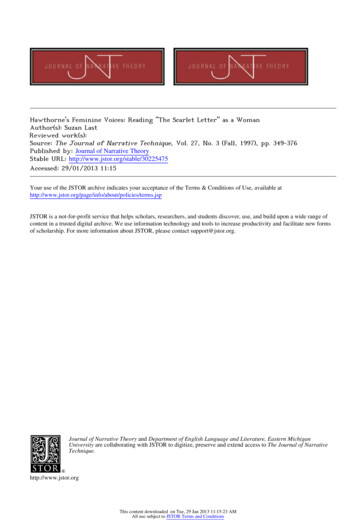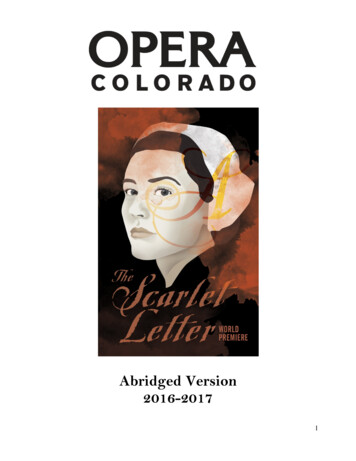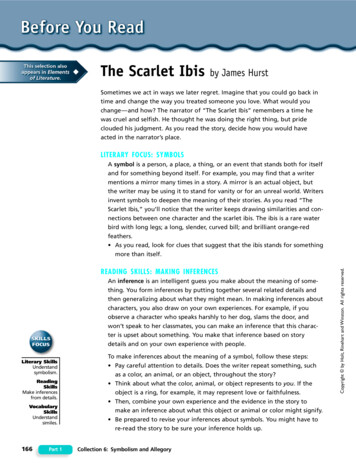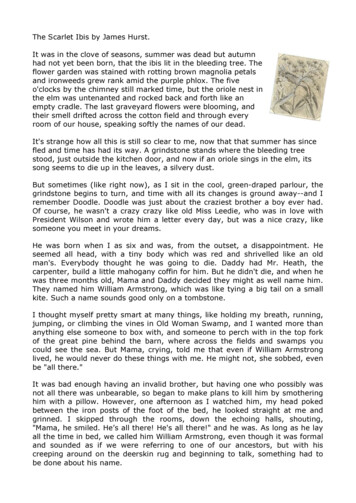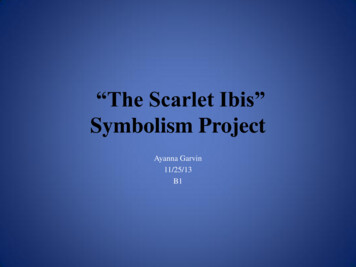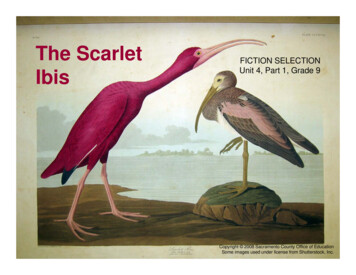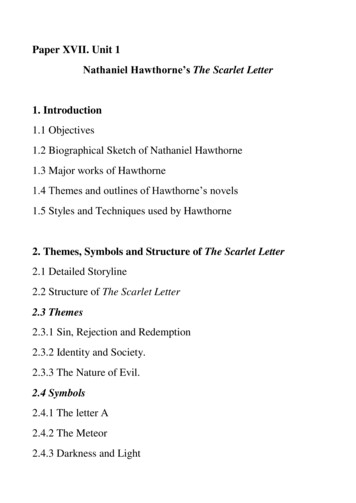
Transcription
Paper XVII. Unit 1Nathaniel Hawthorne’s The Scarlet Letter1. Introduction1.1 Objectives1.2 Biographical Sketch of Nathaniel Hawthorne1.3 Major works of Hawthorne1.4 Themes and outlines of Hawthorne’s novels1.5 Styles and Techniques used by Hawthorne2. Themes, Symbols and Structure of The Scarlet Letter2.1 Detailed Storyline2.2 Structure of The Scarlet Letter2.3 Themes2.3.1 Sin, Rejection and Redemption2.3.2 Identity and Society.2.3.3 The Nature of Evil.2.4 Symbols2.4.1 The letter A2.4.2 The Meteor2.4.3 Darkness and Light
3. Character List3.1 Major characters3.1.1 Hester Prynn3.1.2 Roger Chillingworth3.1.3 Arthur Dimmesdale3.2 Minor Characters3.2.1 Pearl3.2.2 The unnamed Narrator3.2.3 Mistress Hibbins3.2.4 Governor Bellingham4. Hawthorne’s contribution to American Literature5. Questions6. Further Readings of Hawthorne1. Introduction1.1 ObjectivesThis Unit provides a biographical sketch of Nathaniel Hawthorne first. Then a list of his majorworks, their themes and outlines. It also includes a detailed discussion about the styles andtechniques used by him. The themes, symbols and the structure of The Scarlet Letter are discussed
next, followed by the list of major as well as minor characters. This unit concludes with a discussionabout Hawthorne’s contribution to American literature and a set of questions. Lastly there is a list offurther readings of Hawthorne to gain knowledge about the critical aspects of the novel.1.2 Biographical Sketch of Nathaniel HawthorneNathaniel Hawthorne, (1804- 1864), short-story writer and novelist, was one of the foremostnineteenth century writers in America. He was born on 4th July, 1804, in Salem Massachusetts asNathaniel Hathorne. He later added a ‘w’ to avoid association with one of his ancestors, JudgeHathorne. His Puritan ancestors were the first settlers in the state and included two prominent judges.By Hawthorne’s time the family had retired from public eminence.Hawthorne was a quiet, meditative child and a good student. In 1821 he attended Bowdoin Collegein Maine. His classmates were generally of the view that he was aloof. He graduated in1825 with aclass that included the poet H.W Longfellow and Franklin Pierce, who later became the President ofUnited States.Hawthorne was an active writer and published at his own expense a novel called Fanshawe in 1828.He quickly felt it was not up to his quality and attempted to remove all of the copies. For the nextseveral years he created many impressive works such as, An Old Woman’s Tale, The Hollow of theThree Hills, My Kinsman, Major Molineux, Roger Malvin’s Burial, and Young Goodman Brown. In1937, Hawthorne published his first commercial book, Twice Told Tales with little financial gain.In 1839 he obtained a position as an inspector at the Boston Custom House, weighing and measuringthe goods shipped in and out of the harbour. Distracted from doing any literary work, Hawthorne wasglad to be relieved of his job when the administration changed in 1844. Hawthorne moved to Lenox,Massachusetts, where he began writing The House of Seven Gables. In 1851, he wrote The SnowImage and Other Twice Told Tales. From Lennox, Hawthorne moved to Newport, where he wroteThe Blithedale Romance (1852), a book that satarized the pretensions and delusions of socialreformers.Hawthorne was appointed as consul to England from 1853 to 1857. He was dissatisfied with the joband moved to Italy where he wrote his last complete novel, The Marble Faun, (1857). He took ill inthe spring of 1864, and died at Plymouth in New Hampshire on May 19, 1864. He was buried inSleepy Hollow Cemetery in Massachusetts.1.3 Major works of Hawthorne- Novelsi. The House of Seven Gablesii. The Blithedale Romanceiii. The Marble Fauniv. Fanshawe
- Short Stories Collectioni. Twice-Told Talesii. Tanglewood Tales: A Wonder Book for Girls and Boysiii. Mosses from an Old Hill Manse- Selected Short Storiesi. Rappaccini’s Daughterii. The Birth-Mark and Other Storiesiii. The Minister’s Black Veiliv.Young Goodman Brown1.4 Themes and Outlines of Hawthorne’s novelsFor his novels, Hawthorne drew on Puritan orthodox thought to examine the individual andcollective consciousness under the pressure of suffering. He sought to dramatize themes such as sin,guilt and punishment. His writing is marked by introspective depth and an urge to get inside thecharacter he created. He attempts to give a genuine picture of the times by presenting a realisticsetting and real puritanical philosophies.Hawthorne frequently focussed more on a character’s inner struggle or a central theme than onheated encounters between characters. One of Hawthorne’s recurring themes throughout his workswas his own view on human nature. He explored an interesting human psychology through hisexploration of the dark side of human consciousness. In The Scarlet Letter, Hawthorne introduced aprofound comment on the breakdown of human relationships in the society of the seventeenthcentury. His theme that human nature is full of wickedness is also evident in Young Goodman Brownwhen the title character faced great difficulty is resisting temptation.Hawthorne’s modern themes were modelled by his own religious beliefs. For example, he raisedquestions concerning the morality and necessity of Hester’s exile in The Scarlet Letter. One reasonfor these inquiries was Hawthorne’s disbelief in heaven, hell, angels or devils since modern sciencewas undermining the Bible. He also employed allegory as a way of presenting themes. He achieved itby placing characters in a situation outside of the ordinary. He explored the themes of penance forsins and cowardliness when Dimmesdale struggled with himself to make his sin public.In conclusion, Hawthorne’s literary style did indeed contain elements such as description anddialogue which seemed out of place when compared to modern twentieth century literature.However, his style was typical of the literary style of the time.1.5 Styles and Techniques used by HawthorneHawthorne shaped his own literary style. Although his writing style was viewed as outdated whencompared to modern literature, he conveyed modern themes of psychology and human nature
through the use of allegory and symbolism. During the time when he wrote, printing technology wasnot advanced enough to reproduce photographs in books. Therefore Hawthorne frequently wrotelengthy visual descriptions. One example of such description is in The Scarlet Letter whenHawthorne intricately describes the prison door and its surroundings. Another aspect of his writingwhich was exclusive to his time was the use of formal dialogue which remained consistent fromcharacter to character. He adopted this technique partly from a British writer, Sir Walcott Scott,whose works were popular in the United States and Great Britain. Sir Scott used an unknown,mysterious character whose main function is to add mystery and complicate the plot. We find thatcharacter in Chillingworth in The Scarlet Letter. The caricature of minor characters, somebodyexaggerated or distorted was found in Sir Scott’s works, we find a likeness of that in MistressHibbins in The Scarlet Letter. Sir Scott used elaborately detailed scenes planned on a huge scale, wefind that in the initial scaffold scene as well as in the third scaffold scene where Dimmesdaleconfesses his sin, of The Scarlet Letter.Although his dialogue was overly formal, it was an accurate tool to describe human emotion. Healso uses some of the techniques used in theatres, for example, the action in his novels are seen as ifthey were being enacted on stage. The audience’s point of view is of much importance, also thereflections of some characters are perceived as asides. He was also fascinated by some of the manydevices of the Gothic novel. He used them immediately in the initial chapter, when describing thescarlet letter, and the effects it provokes on him; later with the description of Hester’s dark prison,Bellingham’s elaborately decorated mansion and with the sinister descriptions of the Puritanministers. Besides, we find some Gothic Elements in Chillingworth’s appearance.Chapter wise Summary and Analysis:SummaryHawthorne begins The Scarlet Letter with a long introductory essay that generally functions as apreface but, more specifically, accomplishes four significant goals: outlines autobiographicalinformation about the author, describes the conflict between the artistic impulse and the commercialenvironment, defines the romance novel (which Hawthorne is credited with refining and mastering),and authenticates the basis of the novel by explaining that he had discovered in the Salem CustomHouse the faded scarlet A and the parchment sheets that contained the historical manuscript on whichthe novel is based.AnalysisThe preface sets the atmosphere of the story and connects the present with the past. Hawthorne'sdescription of the Salem port of the 1800s is directly related to the past history of the area. ThePuritans who first settled in Massachusetts in the 1600s founded a colony that concentrated on God'steachings and their mission to live by His word. But this philosophy was eventually swallowed up bythe commercialism and financial interests of the 1700s.The clashing of the past and present is further explored in the character of the old General. The oldGeneral's heroic qualities include a distinguished name, perseverance, integrity, compassion, andmoral inner strength. He is "the soul and spirit of New England hardihood." Now put out to pasture,he sometimes presides over the Custom House run by corrupt public servants, who skip work to
sleep, allow or overlook smuggling, and are supervised by an inspector with "no power of thought,nor depth of feeling, no troublesome sensibilities," who is honest enough but without a spiritualcompass.A further connection to the past is his discussion of his ancestors. Hawthorne has ambivalent feelingsabout their role in his life. In his autobiographical sketch, Hawthorne describes his ancestors as "dimand dusky," "grave, bearded, sable-cloaked, and steel crowned," "bitter persecutors" whose "betterdeeds" will be diminished by their bad ones. There can be little doubt of Hawthorne's disdain for thestern morality and rigidity of the Puritans, and he imagines his predecessors' disdainful view of him:unsuccessful in their eyes, worthless and disgraceful. "A writer of story books!" But even as hedisagrees with his ancestor's viewpoint, he also feels an instinctual connection to them and, moreimportantly, a "sense of place" in Salem. Their blood remains in his veins, but their intolerance andlack of humanity becomes the subject of his novel.This ambivalence in his thoughts about his ancestors and his hometown is paralleled by his strugglewith the need to exercise his artistic talent and the reality of supporting a family. Hawthorne wrote tohis sister Elizabeth in 1820, "No man can be a Poet and a Bookkeeper at the same time."Hawthorne's references to Emerson, Thoreau, Channing, and other romantic authors describe anintellectual life he longs to regain. His job at the Custom House stifles his creativity and imagination.The scarlet letter touches his soul (he actually feels heat radiate from it), and while "the reader maysmile," Hawthorne feels a tugging that haunts him like his ancestors.In this preface, Hawthorne also shares his definition of the romance novel as he attempts to imagineHester Prynne's story beyond Pue's manuscript account. A careful reading of this section explains theauthor's use of light (chiaroscuro) and setting as romance techniques in developing his themes.Hawthorne explains that, in a certain light and time and place, objects ". . . seem to lose their actualsubstance, and become things of intellect." He asserts that, at the right time with the right scenebefore him, the romance writer can "dream strange things and make them look like truth."Finally, the preface serves as means of authenticating the novel by explaining that Hawthorne haddiscovered in the Salem Custom House the faded scarlet A and the parchment sheets that containedthe historical manuscript on which the novel is based. However, we know of no serious, scholarlywork that suggests Hawthorne was ever actually in possession of the letter or the manuscript. Thistechnique, typical of the narrative conventions of his time, serves as a way of giving his story an airof historic truth. Furthermore, Hawthorne, in his story, "Endicott and the Red Cross," published nineyears before he took his Custom House position, described the incident of a woman who, like HesterPrynne, was forced to wear a letter A on her breast.SummaryIn this first chapter, Hawthorne sets the scene of the novel — Boston of the seventeenth century. It isJune, and a throng of drably dressed Puritans stands before a weather-beaten wooden prison. In frontof the prison stands an unsightly plot of weeds, and beside it grows a wild rosebush, which seems outof place in this scene dominated by dark colors.
AnalysisIn this chapter, Hawthorne sets the mood for the "tale of human frailty and sorrow" that is to follow.His first paragraph introduces the reader to what some might want to consider a (or the) majorcharacter of the work: the Puritan society. What happens to each of the major characters — Hester,Pearl, Dimmesdale, and Chillingworth — results from the collective ethics, morals, psyche, andunwavering sternness and rigidity of the individual Puritans, whom Hawthorne introducesfiguratively in this chapter and literally and individually in the next.Dominating this chapter are the decay and ugliness of the physical setting, which symbolize thePuritan society and culture and foreshadow the gloom of the novel. The two landmarks mentioned,the prison and the cemetery, point not only to the "practical necessities" of the society, but also to theimages of punishment and providence that dominate this culture and permeate the entire story.The rosebush, its beauty a striking contrast to all that surrounds it — as later the beautifullyembroidered scarlet A will be — is held out in part as an invitation to find "some sweet moralblossom" in the ensuing, tragic tale and in part as an image that "the deep heart of nature" (perhapsGod) may look more kindly on the errant Hester and her child (the roses among the weeds) than doher Puritan neighbors. Throughout the work, the nature images contrast with the stark darkness of thePuritans and their systems. Hawthorne makes special note that this colony earlier set aside land forboth a cemetery and a prison, a sign that all societies, regardless of their good intentions, eventuallysuccumb to the realities of man's nature (sinful/punishment/prison) and destiny(mortal/death/cemetery). In those societies in which the church and state are the same, when manbreaks the law, he also sins. From Adam and Eve on, man's inability to obey the rules of the societyhas been his downfall.The Puritan society is symbolized in the first chapter by the plot of weeds growing so profusely infront of the prison. Nevertheless, nature also includes things of beauty, represented by the wildrosebush. The rosebush is a strong image developed by Hawthorne which, to the sophisticatedreader, may sum up the whole work. First it is wild; that is, it is of nature, God given, or springingfrom the "footsteps of the sainted Anne Hutchinson." Second, according to the author, it is beautiful— offering "fragrant and fragile beauty to the prisoner" — in a field of "unsightly vegetation." Third,it is a "token that the deep heart of Nature could pity and be kind to" the prisoner entering thestructure or the "condemned criminal as he came forth to his doom." Finally, it is a predominantimage throughout the romance. Much the same sort of descriptive analyses that can be written aboutthe rosebush could be ascribed to the scarlet letter itself or to little Pearl or, perhaps, even to the actof love that produced them both.Finally, the author points toward many of the images that are significant to an understanding of thenovel. In this instance, he names the chapter "The Prison Door." The reader needs to pay particularattention to the significance of the prison generally and the prison door specifically. The descriptivelanguage in reference to the prison door — ". . . heavily timbered with oak, and studded with ironspikes" and the "rust on the ponderous iron-work . . . looked more antique than anything else in theNew World" and, again, ". . . seemed never to have known a youthful era" — foreshadows and setsthe tone for the tale that follows.GlossaryCornhill part of Washington Street. Now part of City Hall Plaza.Isaac Johnson a settler (1601-1630) who left land to Boston; he died shortly after the Puritansarrived. His land would be north of King's Chapel (1688), which can be visited today.
burdock any of several plants with large basal leaves and purple-flowered heads covered withhooked prickles.pigweed any of several coarse weeds with dense, bristly clusters of small green flowers. Also calledlamb's quarters.apple-peru a plant that is part of the nightshade family; poisonous.portal here, the prison door.Anne Hutchinson a religious dissenter (1591-1643). In the 1630s she was excommunicated by thePuritans and exiled from Boston and moved to Rhode IslandSummaryThe Puritan women waiting outside the prison self-righteously and viciously discuss Hester Prynneand her sin. Hester, proud and beautiful, emerges from the prison. She wears an elaboratelyembroidered scarlet letter A — standing for "adultery" — on her breast, and she carries a threemonth-old infant in her arms.Hester is led through the unsympathetic crowd to the scaffold of the pillory. Standing alone on thescaffold as punishment for her adulterous behavior, she remembers her past life in England and onthe European continent. Suddenly becoming aware of the stern faces looking up at her, Hesterpainfully realizes her present position of shame and punishment.AnalysisAlthough the reader actually meets only Hester and her infant daughter, Pearl, in this chapter,Hawthorne begins his characterization of all four of the novel's major characters. He describes Hesterphysically, and he tells about her background, illustrating her pride and shame. Then we see Pearland hear her cry out when her mother fiercely clutches her at the end of the chapter. Although Pearlis one of the physical symbols of Hester's sin (the other is the scarlet A), she is much more than that.She is the product of an act of love — socially forbidden love as it may have been — but love still.This is why Pearl, as we later learn, is not amenable to social rules. She was conceived in an act thatwas intolerable in the Puritan code and society.In addition to Hester and Pearl's appearance, we get our first glimpse of the Reverend ArthurDimmesdale and Roger Chillingworth, the novel's other two main characters. Although the irony ofDimmesdale's relationship to Hester is not yet apparent, his grief over his parishioner Hester iscommented on by one of the women assembled near the prison who notes that Dimmesdale "takes itvery grievously to heart that such a scandal should have come upon his congregation." And, althoughRoger Chillingworth is not yet named, we are given a rather full characterization of the man throughHester's recollections of him. He is the "misshapen scholar" who is Hester's legal husband.Chapter 2 also contains a description of the Puritan society and reveals Hawthorne's critical attitudetoward it. The smugly pious attitude of the women assembled in front of the prison who condemnHester is frightening — especially when we hear them suggest that Hester should be scalded with ahot iron applied to her forehead to mark her as a "hussy," an immoral woman. Although this scenevividly dramatizes what Hawthorne found objectionable about early American Puritanism, he avoidsover-generalizing here by including the comments of a good-hearted young wife to show that not allPuritan women were as bitter and pugnaciously pious as these "gossips." The young woman's softremarks of sympathy for Hester's suffering contrast sharply with the comments of the majority of thewomen. It is important to note, however, that even this young mother has brought her child towitness the punishment, passing these morals and behaviors to the next generation.
When Hester appears with Pearl, she is in stark contrast to the gloom and the grim reality of thecrowd. She has a natural grace and dignity and rejects the arm of the beadle, walking into thesunlight on her own. The most startling part of her appearance is the scarlet letter A on her dress.What is meant to be a badge of shame is elaborately decorated in threads of gold. It goes far beyondthe standards of richness — sumptuary laws — decreed by the colony. Her extraordinary appearancedefies the order of the governor and the ministers. The scarlet letter is "fantastically embroidered andilluminated" and takes "her out of the ordinary relations with humanity" and into a sphere all herown. The red of the letter, standing for adultery, reminds the reader of the rosebush and the letter thatlater appears in the sky. Its color, for now at least, is associated with her sin and will be stronglyconnected to Pearl throughout the novel.Stylistically, the chapter employs a somewhat heavy historical narrative, occasionally interrupted byHawthorne's comments. It also uses such symbols as the beadle, the scarlet letter A, and Pearl. Infact, many of the novel's themes become apparent by investigating the images and symbolsrepresented in the characters, physical objects, and larger social issues. For example, the beadle, ortown crier, who carries a sword and walks with a staff symbolic of religious — and therefore social— authority, is described as "grim and grisly." This description also characterizes , both theatmosphere in Chapter 2 and, more important, the society of which the beadle is a part. As the novelprogresses, Pearl, the offspring of Hester's adulterous affair, becomes more strongly linked to thescarlet letter A that Hester wears on her clothing; likewise, both Pearl's and the A's symbolism arealso more fully developed.GlossaryPhysiognomies: facial features and expression, esp. as supposedly indicative of characterAntinomian: a believer in the Christian doctrine that faith alone, not obedience to the moral law, isnecessary for salvation; to the Puritans, the Antinomian doctrine is heretical.Heterodox: religious person who disagrees with church beliefs; unorthodox.Petticoat and farthingale: underskirts and hoops beneath them.The man-like Elizabeth Queen: Elizabeth I of England (1558-1603), characterized as havingmasculine qualities.Gossip: a person who chatters or repeats idle talk and rumorsBeadle: a minor parish officer who keeps order in church.Ignominy: shame and dishonor; infamy.Rheumatic: flannel material worn to keep warm, especially to ease the pain of rheumatism in thejoints.An hour past meridian: 1:00 p.m.Pillory stocks: where petty offenders were formerly locked and exposed to public scorn.
Papist: a Roman Catholic; the Puritans thought them to be heretics.Spectral: of, having the nature of, or like a specter; phantom; ghostly; supernatural.Phantasmagoric: dreamlike; fantastic.Elizabethan ruff: an elaborate collar worn around the neck, consisting of tiny accordion pleats.SummaryHester recognizes a small, rather deformed man standing on the outskirts of the crowd and clutchesPearl fiercely to her bosom. Meanwhile, the man, a stranger to Boston, recognizes Hester and ishorror-struck.Inquiring, the man learns of Hester's history, her crime (adultery), and her sentence: to stand on thescaffold for three hours and to wear the symbolic letter A for the rest of her life. The stranger alsolearns that Hester refuses to name the man with whom she had the sexual affair. This knowledgegreatly upsets him, and he vows that Hester's unnamed partner "will be known! — he will be known!— he will be known!"The Reverend Mr. Dimmesdale, visibly upset, pleads with Hester to name her accomplice. He tellsher that she should name her partner in sin because perhaps the man doesn't have the courage to stepforward even if he wants to. Yet despite Dimmesdale's passionate appeal, followed by harsherdemands from the Reverend Mr. Wilson and from a stern voice in the crowd (presumably that of thedeformed stranger), Hester steadfastly refuses to name the father of her child. After a long andtedious sermon by the Reverend Mr. Wilson, during which Hester tries ineffectively to quiet Pearl'scrying, she is led back to prison.AnalysisThe novel's other two principal characters now make their first physical appearance, and the tensionsof the story begin to develop. In Chapter 4, the reader learns that the stranger who so terrifies Hestercalls himself Roger Chillingworth, a pseudonym he has chosen for himself. In reality, he is RogerPrynne, the husband whom Hester fears meeting face to face. The other principal character is theyoung Reverend Dimmesdale, who pleads with Hester to name the father of her infant daughter;Dimmesdale is Pearl's father.Hawthorne's portrayal of Chillingworth emphasizes his physical deformity. More important,Chillingworth's misshapen body reflects (or symbolizes) the evil in his soul, which builds as thenovel progresses. In this chapter, Hawthorne provides hints of just how obsessed Chillingworth willbecome with punishing Dimmesdale. For example, when Chillingworth recognizes Hester standingalone on the scaffold, "a writhing horror twisted itself across his features, like a snake gliding swiftlyover them . . ." Characteristic of Chillingworth, he internalizes "into the depths of his nature" thisexternal convulsion, which will feed his appetite for revenge throughout the novel. The image of thesnake is apt when we recall the serpent in the biblical Garden of Eden and the carnal knowledge thatit represents. From this chapter forward, revenge and punishment for Dimmesdale will beChillingworth's only consuming passion.
Dimmesdale's one-paragraph speech to Hester reveals more about his character than any descriptionof his physical body and nervous habits that Hawthorne provides. Knowing that he was Hester'ssexual partner and is Pearl's father, the speech that he gives is ripe with double meanings. On onelevel, he gives a public chastisement of Hester for not naming her lover; on another level, he makes apersonal plea to her to name him as her lover and Pearl's father because he is too morally weak to doso himself. Ironically, what is initially intended to be a speech about Hester becomes more acommentary about his own sinful behavior.In his speech, Dimmesdale asks Hester to recognize his "accountability" in addressing her, and hebegs her to do what he cannot do himself. Publicly, he is her spiritual leader, and, as such, he isresponsible for her moral behavior. Privately, however, he was her lover, and he shares the blame ofthe horrible situation that she is in. He then admonishes her, as her spiritual leader, to name heraccomplice so that her soul might find peace on earth and, more important, so that she might betterher chance for salvation after her death. When he then goes on to "charge" her with naming thetransgressor, we understand that he is privately pleading with her to expose him publicly and therebyhelp ensure his salvation, for without public repentance salvation is not attainable.The dichotomy between Dimmesdale's public speech and personal meaning is most evident in thephrase "believe me." This phrase comes directly following his plea that Hester not take intoconsideration any feelings she might still have for him. It also follows acknowledgment — privatelyto himself, but through public speech — that it would be better for him to step down "from a highplace" and publicly stand beside her on the scaffold. Ultimately, his official, public duty and hisprivate, personal intention are one and the same: to admonish Hester to expose her lover's — his own— immorality because he is too morally weak to do so himself.GlossaryDaniel: a prophet from the Old Testament.Governor Bellingham (1592-1672): the governor of Massachusetts Bay Colony.Halberds: combination battle-axes and spears used in the 15th and 16th centuries.Skull-cap: a light, closefitting, brimless cap, usually worn indoors.SummaryBack in her prison cell, Hester is in a state of nervous frenzy, and Pearl writhes in painfulconvulsions. That evening, when Roger Chillingworth enters Hester's prison cell, she fears hisintentions, but he gives Pearl a draught of medicine that eases the child's pain almost immediately,and she falls asleep. After he persuades Hester to drink a sedative to calm her frayed nerves, the twosit and talk intimately and sympathetically, each of them accepting a measure of blame for Hester'sadulterous affair.Chillingworth, the injured husband, seeks no revenge against Hester, but he is determined to discoverthe father of Pearl. Although this unidentified man doesn't wear a scarlet A on his clothes as Hesterdoes, Chillingworth vows that he will "read it on his heart." He then makes Hester promise not to
reveal his identity. Hester takes an oath to keep Chillingworth's identity a secret, although sheexpresses the fear that her vow of silence may prove the ruin of her soul.AnalysisUnlike the previous chapter, Hawthorne does not summarize or discuss the actions of his characters,nor does he tell the readers what to think. Instead, he puts Hester and Chillingworth together and letsthe reader learn about their attitudes and their relationship to each other through their dialogue. Byjuxtaposing heavily prosaic chapters, like Chapter 3, with ones dominated by the characters'dialogue, Hawthorne creates a pattern in the novel that heightens the dramatic content of the dialogicchapters.Chapter 4 is especially important to understanding Chillingworth. Hawthorne gives
2. Themes, Symbols and Structure of The Scarlet Letter 2.1 Detailed Storyline 2.2 Structure of The Scarlet Letter 2.3 Themes 2.3.1 Sin, Rejection and Redemption 2.3.2 Identity and Society. 2.3.3 The Nature o

